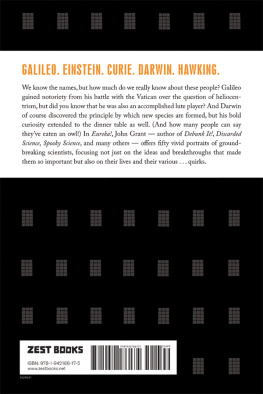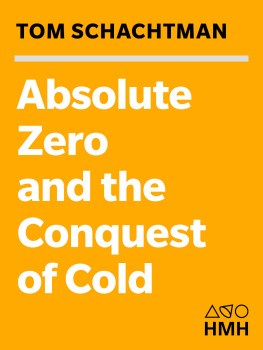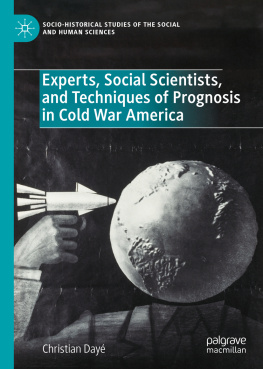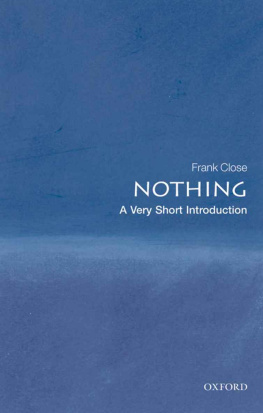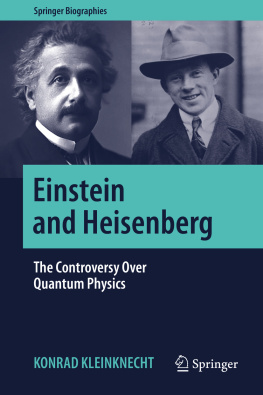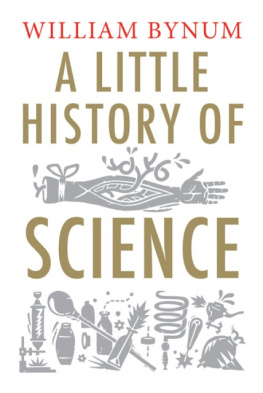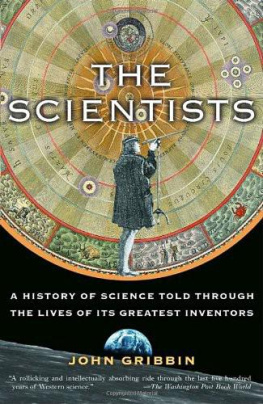A Mariner Book
HOUGHTON MIFFLIN COMPANY
BOSTON NEW YORK
First Mariner Books edition 2000
Copyright 1999 by Tom Shachtman
ALL RIGHTS RESERVED
For information about permission to reproduce
selections from this book, write to
Permissions, Houghton Mifflin Company,
215 Park Avenue South, New York,
New York 10003.
Visit our Web site: www.houghtonmifflinbooks.com.
Library of Congress Cataloging-in-Publication Data
Shachtman, Tom, date.
Absolute zero and the conquest of cold / Tom
Shachtman.
p. cm.
Includes index.
ISBN 0-395-93888-0
ISBN 0-618-08239-5 (pbk.)
1. Low temperature research. I. Title.
QC 278. S 48 1999
536'.56dc21 99-33305 CIP
Printed in the United States of America
Book design by Robert Overholtzer
QUM 10 9 8 7 6 5 4
For Mel Berger
Contents
1. Winter in Summer
2. Exploring the Frontiers
3. Battle of the Thermometers
4. Adventures in the Ice Trade
5. The Confraternity of the Overlooked
6. Through Heat to Cold
7. Of Explosions and Mysterious Mists
8. Painting the Map of Frigor
9. Rare and Common Gases
10. The Fifth Step
11. A Sudden and Profound Disappearance
12. Three Puzzles and a Solution
13. Mastery of the Cold
Acknowledgments
Notes
Index
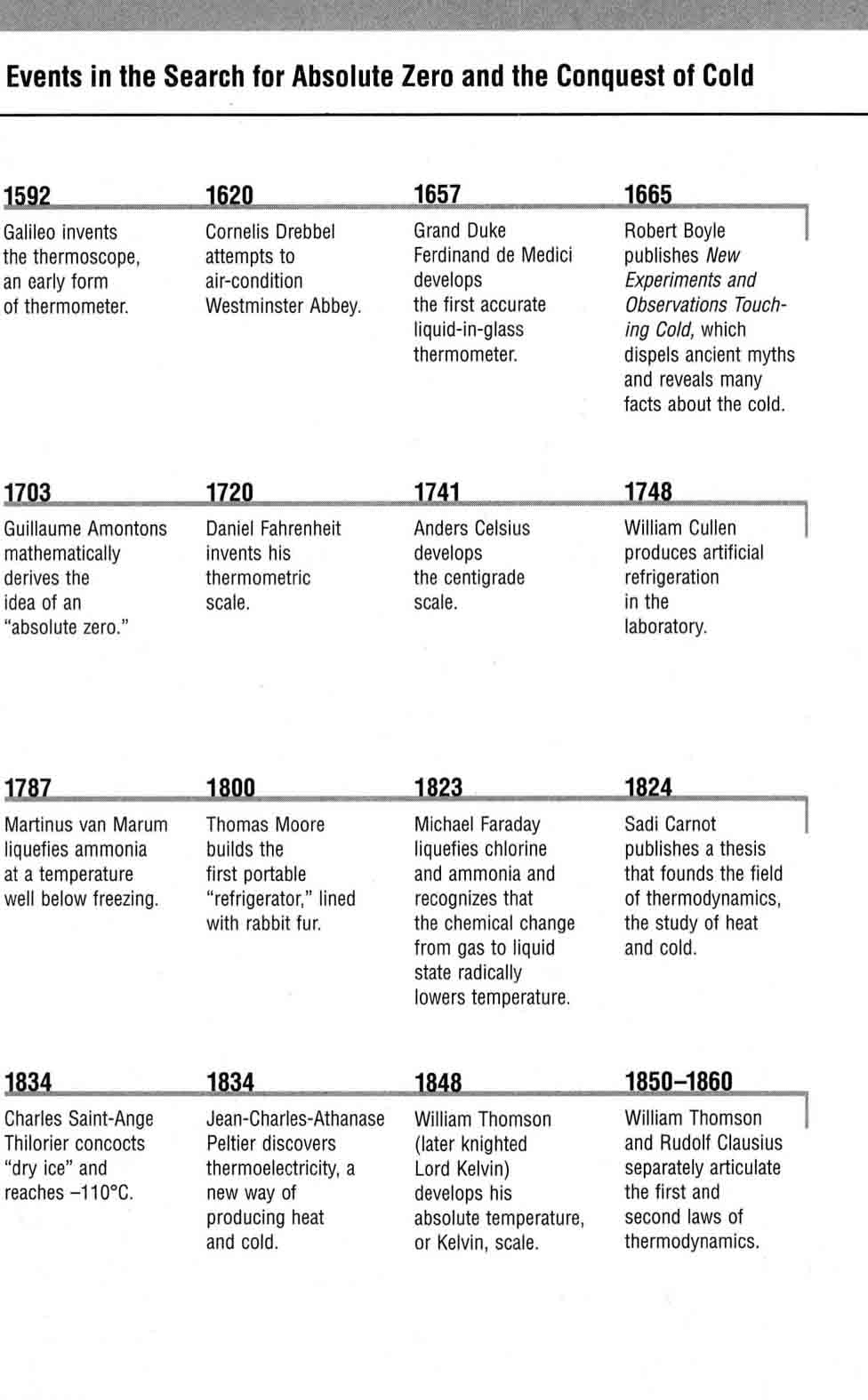

1. Winter in Summer
K ING JAMES I OF ENGLAND AND SCOTLAND chose a very warm day in the summer of 1620 for Cornelis Drebbel's newest demonstration and decreed that it be held in the Great Hall of Westminster Abbey. Drebbel had promised to delight the king by making the atmosphere of some building cold enough in summer to mimic the dead of winter, and by choosing the Great Hall the king gave him an enormous challenge, the largest interior space in the British Isles, 332 feet from one end to the other and 102 feet from the floor to the golden bosses of its vaulted white ceiling.
In 1620 most people considered the likelihood of reversing the seasons inside a building impossible, and many deemed it sacrilege, an attempt to contravene the natural order, to twist the configuration of the world established by God. Early-seventeenth-century Britons and Europeans construed cold only as a facet of nature in winter. Some believed cold had an origin point, far to the north; the most fanciful maps represented Thule, a near-mythical island thought to exist six days' sailing north of the northern end of Britain and supposedly visited only once, by Pytheas in the fourth century B.C. an unexplored, unknown country of permanent cold.
Not until the end of the nineteenth century would a true locus of the cold become a more real destination, as Victorian scientists tried to reach absolute zero, a point they sometimes called "Ultima Thule." Likening themselves to contemporary explorers of the uncharted Arctic and Antarctic regions, these laboratory scientists sought a goal so intense, so horrific, yet so marvelous in its ability to transform all matter that in comparison ice was warm.
In the early seventeenth century, even ordinary winter cold was forbidding enough that the imagination failed when trying to grapple with it. "Natural philosophers" could conceive technological feats that would not be accomplished until hundreds of years laterheavier-than-air flight, ultrarapid ground transportation, the prolongation of life through better medicines, even the construction of skyscrapers and the use of robotsbut not a single human being envisioned a society able to utilize intense cold to advantage. Perhaps this was because while the sources of heat were obviousthe sun, the crackle of a fire, the life force of animals and human beingscold was a mystery without an obvious source, a chill associated with death, inexplicable, too fearsome to investigate.
Abhorrence of cold was reflected in only sporadic use made of natural refrigeration, an omission that permitted a large percentage of harvested grains, meats, dairy products, vegetables, fruits, and fish to spoil or rot before humans could eat them. And since natural refrigeration was so underutilized, producing refrigeration by artificial means was considered a preposterous idea. No fabulist in 1620 could conceive that there could ever be a connection between artificial cold and improving the effectiveness of medicine, transportation, or communications, or that mastery of the cold might one day extend the range of humanity over the surface of the earth, the sky, and the sea and increase the comfort and efficiency of human lives.
How did water become snow in the heavens or ice on the earth? What formed the snowflakes? Why was ice so slippery? In 1620 these and dozens of other age-old, obvious questions about the cold were considered not only unanswerable but beyond the reach of investigation. Cold could neither be measured, nor described as other than the absence of heat, nor created when it was not already presentexcept, perhaps, by a magician.
On that summer day when the king and his party approached Westminster Abbeywhich was in need of some repair, the fabrics torn, the buttresses on the northwest side crumbling in placesJames Stuart was getting on in years, having recently passed his fifty-fourth birthday. In middle age he was still short, broad-shouldered, and barrel-chested, but his hair, once dark, had thinned to a light brown, and the rickets that had affected his growth in youth had lately made his gait more uneven and erratic, requiring him as he walked to lean on a companion's shoulder or arm. He suffered from sudden attacks of abdominal pain, rheumatism, spasms in his limbs, and melancholy. After the loss of his queen, Anne of Denmark, in 1619, he had begun to do uncharacteristic things: even though the king and queen had been estranged and had lived separately for years, James honored Anne in death by siting her sepulcher in Westminster, near the last resting place of his mother, Mary, Queen of Scots. Very few sepulchers or honorary statues decorated the abbey just then.
Summer played havoc with the king's delicate skin, described as "soft as taffeta sarsnet," thin, fragile, and subject to frequent outbreaks of itching and to sweating, which exacerbated the itches. He also suffered from a sensitivity to sunlight so severe that undue exposure to the sun overheated him to the point of danger. His susceptibility to heat was worsened by the thick clothing he habitually wore and the doublets specially quilted to resist knife thrusts, an augmentation deemed necessary after several assassination attempts against him. "Look not to find the softness of a down pillow in a crown," the king had written earlier that year, in a small book of meditations on the biblical verse about Jesus crowned with thorns, "but remember that it is a thorny piece of stuff and full of continual cares."
Aside from obtaining relief from the heat, James's interest in the coming demonstration derived from his lifelong obsession with witchcraft and unnatural matters, given fullest flower in his book Demonologie, published in 1597. In 1605, two years after James had ascended to the throne of England upon the death of Queen Elizabeth, his fascination with the occult and his continual search for entertainment led him to accede to an entreaty for patronage by the Dutchman Cornelis Drebbel. James installed Drebbel and his family, with room and board and a grant for expenses, in a suite at Eltham Palace so that Drebbel could set up a laboratory and manufacture, for the particular delight of James's son Henry, such devices as a "perpetual-motion" apparatus, a self-regulating oven, a magic lantern, and a thunder-and-lightning machine.
Next page


